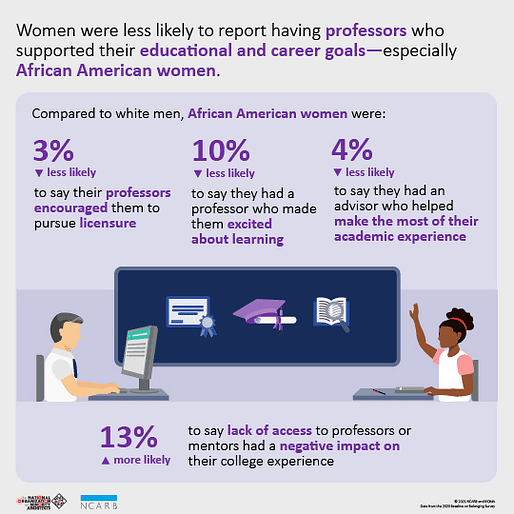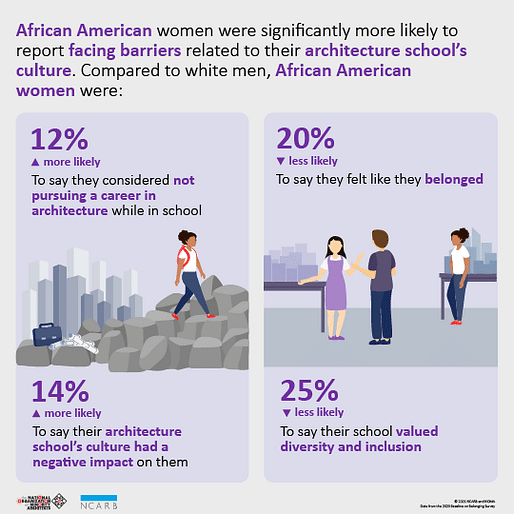
A new report by NCARB and NOMA has found that women, particularly Black or African American women, face heavier challenges in architectural education than their male counterparts. As a result, more than half of Black or African American women surveyed state that they have considered a different career path.
The report is the latest output of the “Baseline on Belonging” study conducted by NCARB and NOMA, which seeks to identify areas where underrepresented groups are disproportionately impacted throughout their early architectural career, including education and licensing. Previous reports within the study have focused on the Architectural Experience Program (AXP) and the Architect Registration Examination (ARE), which found that white and male candidates were more likely to pass the ARE.

The latest report, whose findings are derived from 5,300 survey respondents, found that women feel less supported by professors in pursuing their educational and career goals. In particular, African American women were 10% less likely than white men to say their professor made them excited about learning, and 13% more likely to report a lack of access to professors and mentors, which was negatively impacting their college experience.
The disparities become more pronounced when considering the culture of architecture schools. Compared to white men, African American women were 20% less likely to feel belonged in architecture school, 14% more likely to say they were negatively impacted by their architecture school’s culture, and 25% less likely to say their school valued diversity and inclusion.

The report has also uncovered disparities between NAAB-accredited and non-accredited programs. Graduates of accredited programs were 9% less likely to say their education prepared them for an architectural career, 10% more likely to consider leaving the profession during their education, and 10% more likely to be negatively impacted by their school’s culture.

Graduates of NAAB-accredited programs were also more likely to report financial pressures. NAAB-accredited graduates were 7% more likely to cite the cost of studio materials as an impediment, 9% more likely to cite books as an impediment, and 20% more likely to cite tuition as having a negative impact.
However, financial burdens are not restricted to NAAB-accredited graduates. The cost of studying architecture was the most frequently cited barrier for survey respondents, with over 50% citing tuition as having a negative impact on their education.

“The Baseline on Belonging study highlights the need for two key efforts already underway at NCARB: Exploring additional, accessible pathways to entry into the architecture profession, and the urgent need for the entire architecture community to not only address disparities faced by underrepresented students but to take actions now,” said NCARB President Alfred Vidaurri Jr. on the report’s unveiling. In response, NOMA and NCARB have pledged to conduct further focus groups to sculpt their reforms to the educational process.
Publication of the report comes in the same month that a controversy at SCI-Arc placed labor practices and architecture school culture into the spotlight, leading to two faculty members being placed on leave.
5 Comments
Interesting to ponder what would happen if the "data" showed that these demographics were equal or skewed in the other direction. Do you think that NOMA and NCARB would ever publish it?
Another thing to ponder -- how "studies" like these are used to scare people away from architecture or other science degrees and into dubious soft studies programs, when other degrees cost the same amount (though architecture grad school is a redundant scam for arch undergrads). "Come, be with us in the African American studies department where you feel welcome! The future for this degree is bright!"
Love how you lumped Architecture into a Science degree lol. It should be in the latter category - dubious semi-soft
Yes, architecture has become soft-er over the last 40 years. Softness is inversely proportional to the amount of years required for professional bureaucratic 'mastery' ... from two years to four years to seven years to 15 (to master the art of designing a strip mall).
We are in the information age and this type of information should be used by architecture schools and the profession to improve.Architects should take constructive criticism.The profession has not been scrutinized like others.Its just the beginning.But it might be late.Technology and the nature of real estate development will pose greater challenges to the profession if it does not change to reflect the aspirations of the society.Architecture should be a social sport not a private club.
Block this user
Are you sure you want to block this user and hide all related comments throughout the site?
Archinect
This is your first comment on Archinect. Your comment will be visible once approved.